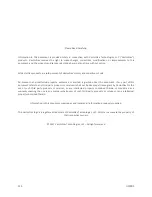
108
UM001
actual attitude which is derived from the flight simulator. Moving from left to right are three separate
types of attitude estimators shown in order based upon the accuracy of their derived solution. The most
accurate solution is proved by the Inertial Navigation System (INS). This type of estimator incorporates
the position and velocity measurements from a GPS along with the accelerometer, and gyroscope in an
optimal fashion to simultaneously estimate attitude and the position and velocity of the vehicle. It
provides the most accurate attitude estimate since it makes no assumptions regarding the accelerometer
measurements.
Measurement Sources for Velocity Aiding
Below are three common sources used for velocity aiding.
Airspeed Sensor
When an airspeed sensor is used for velocity aiding it is important to note which type of airspeed is being
used. Since the airspeed input is being used by the AHRS to estimate the centripical acceleration, the
airspeed used should be ideally close to the actual speed relative to the fixed earth. Normally airspeed
sensors measure the speed of the aircraft relative to the atmosphere, thus there will be a difference
between the speed relative to the fixed Earth and the speed given by the airspeed indicator, equal to the
speed of the atmosphere relative to the ground (wind speed). In high wind conditions this can cause some
increased error in the velocity aiding algorithm.
When using airspeed
Speedometer
For automotive applications the speedometer measurement can be used to perform velocity aiding. The
speedometer measurement will provide the ground speed of the vehicle. There will be some small loss
due to fact that vertical speed is not included, however the effect will be minimal.
GPS
For most applications GPS provides an excellent source of velocity aiding for an AHRS. It is recommended
that you use a GPS receiver with at least a 5Hz update rate.
9.1.1
Tuning for Higher Performance
In most situations the default tuning parameters for the velocity compensation will provide adequate
results without the need for manual adjustment. In the event that you have a case where you need
improved performance, there are tuning parameters provided in the Velocity Compensation Control
Register (Register 50) that provide a means to adjust the behavior of the compensation algorithm.
Velocity Tuning
The velocity tuning field in the Velocity Compensation Control Register in the Velocity Aiding subsystem
provides a means to adjust the uncertainty level used for the velocity measurement in the compensation
estimation filter. The default value is 0.1. A larger value places less trust in the velocity measurements,
while a smaller number will place more trust in the velocity measurement. If your velocity measurement
is noisy or unreliable increasing this number may provide better results. If you have a very accurate
velocity measurement then lowering this number will likely produce better results.





















